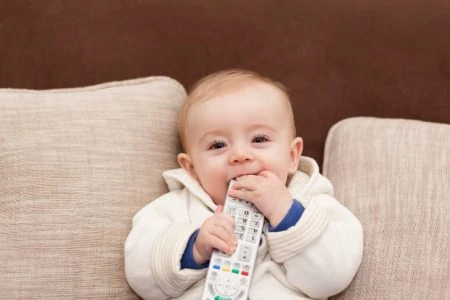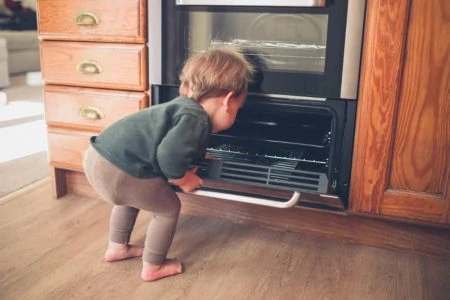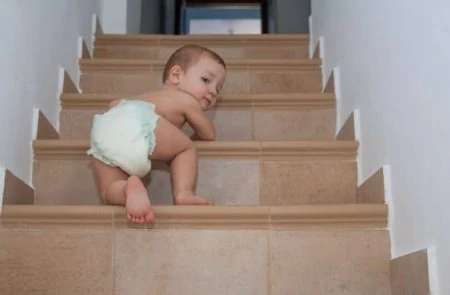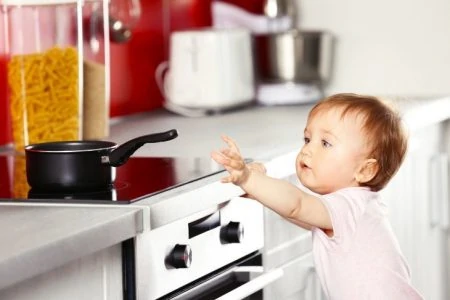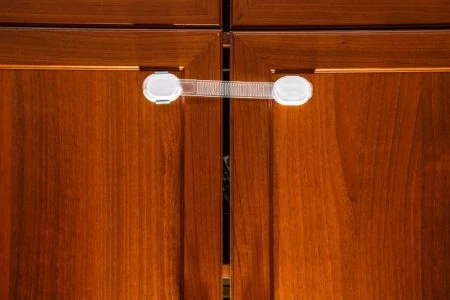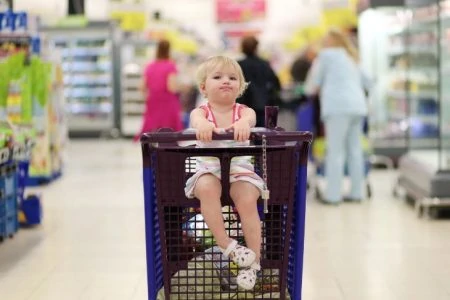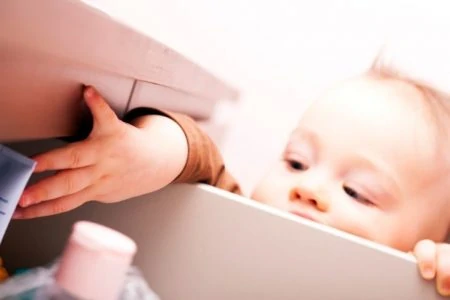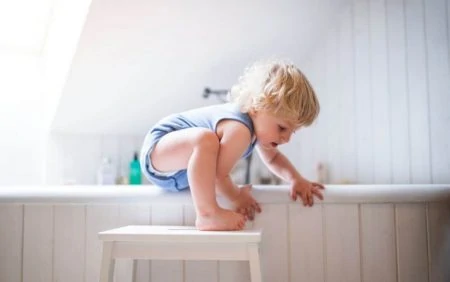We know what it’s like. Your little bundle goes from being totally dependent on you to a little mobile explorer — seemingly overnight.
This is an exciting time, but it can also be frightening as you suddenly see the risks in every room and wonder how you’ll ever keep your child safe.
For most families, the living room is where everyone comes together, but it may also be one of the most dangerous rooms in the house — in some obvious and not-so-obvious ways.
We’ve looked at this challenge from every angle and have created this guide to teach you exactly what you need to do to babyproof your living room.
Key Takeaways
- Babyproof your living room by softening sharp edges, securing unstable furniture, and keeping surfaces clear.
- Ensure TV safety by hiding cords, securing the TV, and blocking off access to the area.
- Babyproof your fireplace with a restrictive gate, softening the hearth, and safely storing fireplace tools.
- Use essential babyproofing items like outlet covers, doorknob covers, baby gates, and cabinet locks.
How to Safety Test Your Furniture
The average living room contains various pieces of furniture, such as couches, desks, bookshelves, and coffee tables. These may seem like everyday objects, but they could mean falls, scrapes, bumps, and cuts to your tiny explorer.
To get a good idea about the safety situation in your living room, it’s a great idea to test all your furniture thoroughly.
1. Feel for Edges and Corners
Have you ever hit your knee on the corner of your heavy wooden coffee table or swiped your shoulder on the side of the bookshelf? It hurts! And it could be even worse for your toddler.
To test for edges and sharp corners, run your hand along and over every edge and corner, and make notes of the ones that seem hazardous. When your little one is learning to crawl, stand, and walk, they will fall and tumble a lot.
It’s important to know where the bumping danger zones are.
2. Change Your Perspective
Get down on your hands and knees and look at your living room from an entirely new angle. From up high, things may seem less dangerous than they are at the same eye level as your toddler.
Once you start looking from a child’s perspective, you’ll begin to notice things that may attract curious fingers or are just waiting to be run into. Spotting problems from down low helps prevent you from missing any key details you may not have noticed while standing.
3. Wobble Your Furniture
Toddlers aren’t very strong, but they can get into more trouble than you’d think. When learning to crawl or beginning to walk, kids will tug on anything they can reach and use it for support. Can your furniture withstand a tiny human throwing their body weight at it?
The best way to answer this is to try it for yourself. Using the equivalent of your toddler’s strength, gently shake any furniture that could be less secure than it seems. This could be anything from a bookcase to a decorative plant.
Anything that tips easily is bad news, but what can you do about it?
6 Tips for Babyproofing Your Furniture
Once you’ve identified the danger zones and know which furniture is most likely to pose a risk to your curious tot, you can move on to the really exciting stage.
Welcome to babyproofing!
Babyproofing furniture is a big job, but it doesn’t have to be expensive or extremely time-consuming.
Identify the key areas and solve problems creatively to keep your home safe without breaking the bank or entirely changing the aesthetic of your living room.
1. Soften Up
Remember those edges you searched for? It’s time to soften them up. You can do this in many ways, from DIY fixes to store-bought solutions.
Every family and living room decor will require a different remedy, but here are some of the best ways to keep your little one from hurting themselves on sharp corners.
- Buy corner protectors.
- Invest in edge guards.
- Use plumbing foam pipe to cover edges.
- Use hollow pool noodles to cover edges.
Whether you hit the baby store or the hardware store, there are plenty of online tutorials to show you the way forward.
2. Remove Unstable Furniture
Some things can’t be fixed up for a baby. The good news is that they won’t be small forever, but while they are, store floor lamps and breakable vases or potted plants out of reach.
If you’re using baby gates or are willing to rearrange your furniture, move these unstable breakables to areas your baby can’t access.
3. Keep Surfaces Clear
The more clutter on your flat surfaces, the more your baby will be drawn to explore them. Coffee tables with open cups or easily accessible electronics are dangerous and asking for a mess!
Staying on top of organization and tidiness is a great way to beat danger and minimize cleaning after a long day of chasing kiddos around. Find alternative storage places for clutter, and move objects up higher out of reach.
4. Lay Down a Non-Slip Rug

Rugs are an easy safety solution for hardwood floors or tiles. They offer a soft place to land and double as a playmat. (Plus, the right rug can really pull a room together!)
Many rugs are manufactured with non-slip bottoms. However, if you already have a rug that isn’t non-slip and you’re not willing to part with it, consider investing in a rug pad.
Budgeting Tip
5. Find Safe Alternatives
If you have the means to do so, replacing some of the furniture in your living room can go a long way in the safety department. Some of the most dangerous objects in your living room have safe, stylish alternatives.
Consider switching your coffee table for an ottoman. Many ottomans offer extra storage, and you can rest your feet on top without worrying about the hard edges of a coffee table.
Other common troublesome objects are floor lamps and curtains. If you change your floor lamp for a table lamp and swap floor-length curtains for blinds, you eliminate two major danger zones from your living room.
6. Strategically Arrange Your Furniture
By using couches, baskets, or other natural barriers, you can make a play area for your toddler while keeping the danger zones off-limits. Baby gates can play a big part in this too.
Some rearranging can go a long way. Place a large decorative pillow or bean bag chair in front of outlets or wall lamps for a kid-friendly area. Get creative and shove things back and forth until you find what works.
Moving Tip
Safety Testing Your TV
Any electronic device is like the Bat-signal for your kid — they’re drawn to them like it’s their life’s mission.
Your TV poses a considerable risk for your toddler, so it’s essential that you take these safety test steps in your babyproofing adventure.
1. Check for Cords
Once more, get down low, and see things from your child’s point of view. Do you see all those little flashing lights and big buttons? You can bet money your toddler won’t stop messing with them.
Also, make a note of any hanging cords, exposed plugs, and devices within a toddler’s reach. Think about your child’s safety and the safety of your electronics too. Being aware of what your tiny tot can reach will alert you to things placed directly in harm’s way.
DVD players, game consoles, and TVs aren’t cheap, so avoid a damaging disaster before it happens by relocating them up high.
2. Wobble the TV
Test the stability of the stand and base of your devices — but carefully, to avoid damage. If things wobble a lot, threaten to fall off, or lean drastically, chances are they’re going to hurt your little explorer.
4 Tips For Babyproofing Your TV
The main trick to babyproofing your TV area is hiding things. Fewer objects out in the open, tempting your toddler, means less attention they’ll pay to the area in general.
Here are four tips for creating a safe screen space for your family to enjoy.
1. Hide your Devices
Getting a TV stand with closing cabinets for storage is your best bet at protecting your baby and your electronics. This will reduce the chance of their discovery and solve the problem before it even begins!
If a new TV stand isn’t in the family babyproofing budget, you have other options. Set a small basket next to your TV stand for out-of-sight storage, or you can install a shelf out of reach to place electronics on.
2. Secure the TV
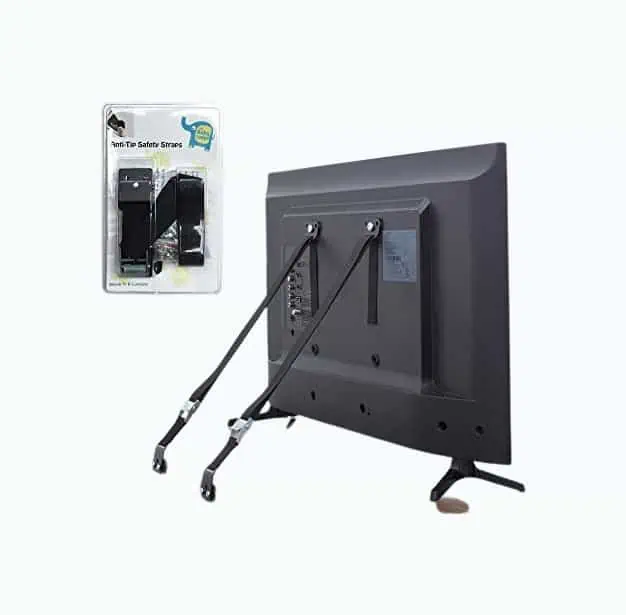
It’s even more important to ensure your TV is secure than it is to get your devices safely out the way. There are a few different ways to do this, but using tension straps is the easiest and least expensive way to get the job done.
These are super easy to put up, and they’re great to have even after your child gets older because they protect your TV from earthquakes or any other accident that could knock it over.
Alternatively, you could mount your TV to the wall. Most retailers will offer TV mounting with the purchase and delivery of your TV, but some places like Best Buy offer these services at any time (1).
If you feel confident, you can mount your TV yourself with the right tools.
3. Block off Access to the TV
If babyproofing the whole area isn’t your cup of tea, you could prevent access instead. Baby gates can help with this. Just remember that if you go this route, you may have to work a little harder to access your devices and television yourself — but it’s still worth it to keep your child safe.
4. Hide or Cover Your Cords
Hanging cords are a major attraction to little ones. The more you have lying around, the more your baby will tug at them and get closer to an outlet. Exposed and reachable cords also pose the risks of your child choking or pulling objects down onto themselves.
You can fasten your cords to a wall or invest in a cord manager device to reduce the risk they pose. Some creative positioning may come in handy here to help hide and mask your cords.
3 Tips For Babyproofing Your Fireplace
We all know that fire and children aren’t a great mix. From the allure of dancing flame to sharp hearthstones, every aspect of a fireplace poses risks to little ones. If you live in a home with a fireplace — whether you use it or not — there are a few handy things you can do to babyproof your fireplace.
1. Get a Restrictive Gate

A 3-in-1 baby gate is amazing in just about any part of your house, but their multi-purpose use really shines through when it comes to blocking off a fireplace.
They can be used to create a playpen for your baby or opened up and extended out to block off large parts of a room.
Investing in one or two of these can be helpful with pets, older children, and blocking other parts of the house.
2. Soften up the Hearth
Unfortunately, corner stickers won’t cut it when it comes to protecting your baby from the hearth. Some people get really creative, but you’ll have to be careful if you plan to use your fireplace.
Here are just a few of the creative and practical ways you can cover up your hearth:
- Cushions.
- Hearth guards.
- A DIY mini couch.
Safety Tip
3. Safely Store Fireplace Tools
Store any fireplace tools out of reach of little ones. Consider putting them in a closet when not in use or blocking them off with a baby gate. These items are all pretty sharp and heavy and could cause significant damage if small hands got a hold of them.
5 Babyproofing Living Room Essentials
Little areas can be just as dangerous to tots as big furniture.
A safe living room and a happy, healthy environment for roaming kiddos should extend to every corner.
1. Outlet Covers
Electrical outlets are hotspots for babies, who love to stick their little fingers into any and every opening.
2. Doorknob Covers
Doorknob covers are perfect for closets, doors leading outside, and even some cabinets. These temporary and affordable covers prevent your toddler from turning any knob and getting into trouble.
3. Baby Gates
We’ve said it once, and we’ll say it again: we love baby gates! From the 3-in-1 model to short-and-shallow or extending gates, baby gates are a safety essential for every doorway.
4. Cabinet Locks
It’s no joke that a kid will get their hands into anything they can, so you have to babyproof cabinets and drawers too. Cabinet safety locks and latches are easy to install when babyproofing.
Safety locks come in many varieties, so you can find the best one for your budget and style.
5. Children’s Sofa
One of the best methods you can use for keeping your little ones off of the grown-up furniture is distraction. Give your little one an area of their own to make your seats seem less appealing.
5 Ways To Tackle Cleaning
A clean home is a safe home, but that’s much easier said than done when you have kids running around. The good news is that once you’re all set and your living room is babyproofed, you can spend less time stopping curious fingers and more time picking up the wreckage they leave behind.
As moms to many little ones, we’ve babyproofed our homes countless times! These are our top five tips for staying organized and tidy while also keeping the mess to a minimum.
1. Cover Delicate Fabrics
Pay attention to the fabrics and surfaces in your living room, and get furniture covers for delicate fabrics. Some surfaces get sticky easier than others — and they tend to be harder to clean.
Other fabrics, like leather or vinyl, can be easily wiped down and washed off. Special surfaces that are prone to damage will be ruined quicker by kids.
2. Get Baskets for Easy Storage
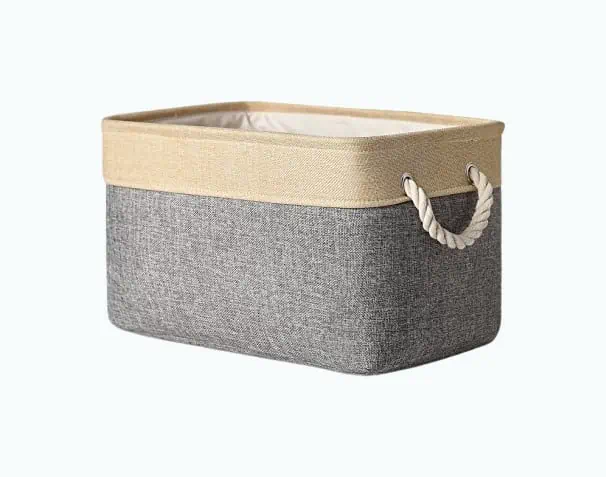
You’ve probably seen it for yourself: toys, cushions, blankets, and a massive assortment of living room accessories strewn about on the floor. We’ve fallen in love with baskets for organizing all kinds of living room clutter!
They’re a great multi-purpose storage option, especially for fun things like toys or pillows. They’re open, visible, stylish, and can be shoved into a corner easily when company comes over.
3. Use Shelves for Decorative Items
Shelves are your best friend when you have little ones. A house with plenty of out-of-reach shelving is a safe house. Keep things up high, yet out of limited storage closets and bins, to help reduce clutter.
This makes cleaning easier and reduces the risk of your belongings being broken.
4. Get a Snacktime Mat
Placemats or floor mats can change the way you look at snack time. Not all moms are willing to let their kids snack away from the table, but if you need a break, throw a mat under a bowl of Cheerios for easy cleanup.
5. Stash a Hidden Trash Can
We like to use miniature trash cans in a variety of creative places — from our vehicles to our entertainment systems. If your family enjoys eating in the living room or in front of the TV, keep a trash can nearby to help cut down on the crumbs and wrappers that would otherwise end up in the couch.
3 Tips For Babyproof Decorating
Home is where the heart is, and many of us are super attached to how we’ve decorated our living spaces. One major issue we’ve found when babyproofing our entertainment areas is how ugly all the devices were. Although some devices are now designed in a more aesthetically pleasing manner, most still leave a lot to be desired.
After a lot of trial and error, we’ve finally found a few great ways to keep our homes stylish without skimping on safety.
Here are our top three tricks to maintaining a stylish living room your toddler can still thoroughly enjoy.
1. Use Decorative Pillows
One of our favorite go-to distractions when babyproofing the living room and TV areas is to use large pillows. They can cover up cords, distract from potted plants, and bring a modern touch to your living room.
As your kids get older, they’ll enjoy the pillows too. Forts, fights, and lounging are all ways our decorative pillows have become a fun part of our living rooms.
2. Use Flameless Candles
Candles are such a relaxing pleasure, but most parents are afraid to have them around when they have curious little ones.
Battery-operated flameless candles aren’t quite the same as the real thing, but they provide that same element of elegance, warmth, and togetherness that a candle brings to a family room.
3. Store Toys in a Cubby
Another way you can keep your living room and TV area stylish while babyproofing is to add cubic shelving units. You can find storage baskets to fit most units perfectly to store things out of sight, or you can use them to display your decorative items out of reach.
